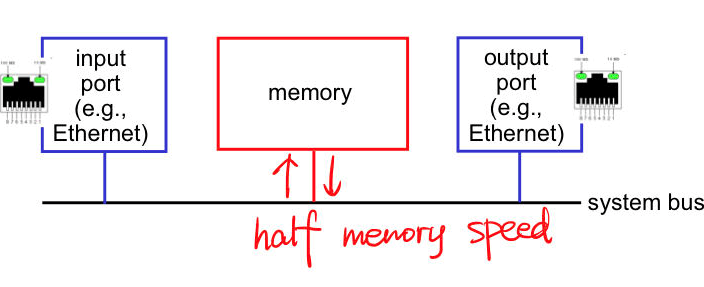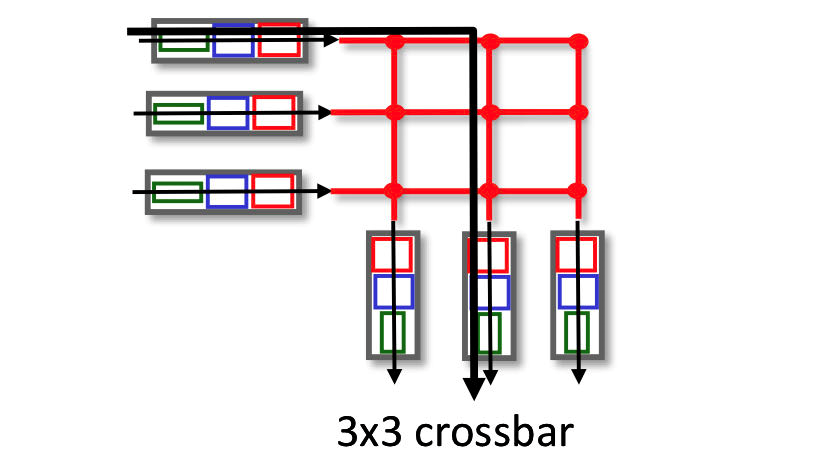Network layer: Data plane¶
Service Model¶
Defines the characteristics of end-to-end delivery of packets
- Individual packet:
- Guaranteed delivery
- Guaranteed delivery with bounded delay
- security
- Datagram flow:
- in-order datagram delivery
- guaranteed minimum bandwidth flow
- restrictions on changes in inter-packet spacing
Best effort service model with Internet: No guarantee on anything.
Pro:
- simplicity → widely deployed/adopted
- with sufficient bandwidth, can provide real-time/band-comsuming services
Success!
Router¶
Generic architecture¶

Input port functions¶

Destination-based Forwarding¶
- based only on destination IP address(traditional)
- Multiple Matching: longest prefix matching
- look up devices: TCAMs(Ternary content addressable memories)
- address → content in 1 clock cycle
- look up devices: TCAMs(Ternary content addressable memories)
Switching¶
| Memory | Bus | Interconnection Network |
|---|---|---|
 |  |  |
Memory: Can utilize at most half of the memory bandwidth
Bus: all output port can receive the packet; only one packet can transmitted on the bus

Multistage switch:
- build big switcher from small ones
- enable parallelism by multiple switching planes
Queuing¶
Input port: switch fabric slower than input ports combined → queuing delay & loss of packet
Head-of-the-line(HOL) blocking: queued datagram at front of the queue prevents others in queue from moving forward (even output port is free at that time)
Output port queuing: when arriving speed is faster than link transmission rate, need a scheduling discipline chooses among queued datagrams for transmission(may have priority)
Buffer¶
\(N\) independent TCP flows, buffering equals to \(B = \frac{\text{RTT}\cdot C}{\sqrt N}\)
Packet Scheduling¶
- Drop
- Marking (Congestion signal)
Packet scheduling: which queued packets are transmitted to output port
- FCFS: First-come-first-served
- Priority: FCFS with multiple priority level
- Round robin: queuing by class
- weighted fair queuing: Generalized Round robin
IP: the Internet Protocol¶
Datagram Format¶

IP address¶
32-bit identifier associated with each host or router's interfaces
"Interfaces": the boundary between the host and the physical link
- router can have multiple interfaces
- host typically have one or two interfaces
- Wireless
- wired ethernet
Dotted-decimal notation: 233.233.233.233
Subnet¶
the part of internet that can physically reach each other without passing a router
Detach interface from hosts/routers, create isolated subnet
CIDR: Classless Interdomain Routing¶
or subnet mask
a.b.c.d/x : leftmost \(x\) bits are network part(network prefix) of IP address
broadcast IP: 255.255.255.255, send to all host in subnet
Classful addressing: subnet can only have 8-, 16- or 24- bit subnet address, known as class A, B and C network
DHCP(Dynamic Host Configuration Protocol)¶
Goal:
- zero configuration/plug-and-play
- renew its lease on address in use
- allow reuse of addresses
- support for mobile users
client-server protocol
DHCP server or DHCP relay agent needed(router)
UDP port 67 & 68
Process (suppose that server is in subnet):
-
host broadcasts: DHCP discover msg[optional]
- destination: 255.255.255.255
- this host: 0.0.0.0
-
DHCP server responds with DHCP offer msg[optional]
- broadcast
- use transaction ID to distinguish different client
- have an IP address valid(lease) time
-
host request IP address: DHCP request msg
- DHCP server sends address: DHCP ack msg
Other function of DHCP:
- address of first-hop router for client
- name & IP address of DNS server
- network mask
ICANN & IP allocation¶
NAT¶
all devices in local network share just one IPv4 address to outside
leave local network with same source address, different port number
10/8, 172.16/12, 192.168/16 prefix are private networks
advantages:
- just need one public IP address
- can change local address/ISP without noticing other parts
- privacy
implementation: NAT router, maintain a NAT translation table
- assign port number for outgoing datagram
disadvantages:
- violate end-to-end arguments
- need NAT traversal to connect a server behind NAT router
IPv6¶
128-bit address
Datagram Format¶

- no checksum(end-to-end)
- no fragmentation/reassembly
- no options
Tunneling: IPv6 datagram carried as payload in IPv4 datagram
Generalized Forwarding & SDN¶
Generalized Forwarding: based on any set of header field values
abstraction: match plus action(match bits in arriving packet, take action)
Flow table¶
flow: header field values(in link-, network-, transport-layer fields)

generalized forwarding: simple packet-handling rules
- match: pattern values in packet header fields
- actions: for matched packet
- drop
- forward
- modify [change counter/address]
- send to controller
- priority
- counters: #bytes, #packets and #time
Can be used as: router, firewall, switch, NAT
Middleboxes¶
“any intermediary box performing functions apart from normal, standard functions of an IP router on the data path between a source host and destination host”
Three types of services performed by middleboxes:
- NAT Translation
- Security Services
- Performance Enhancement